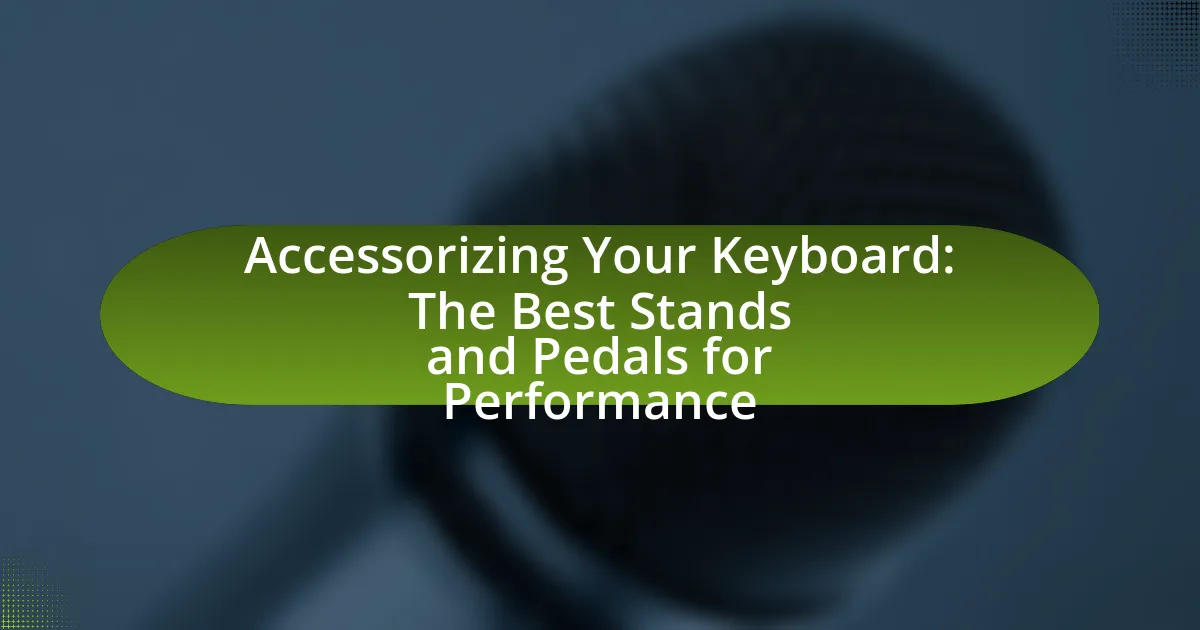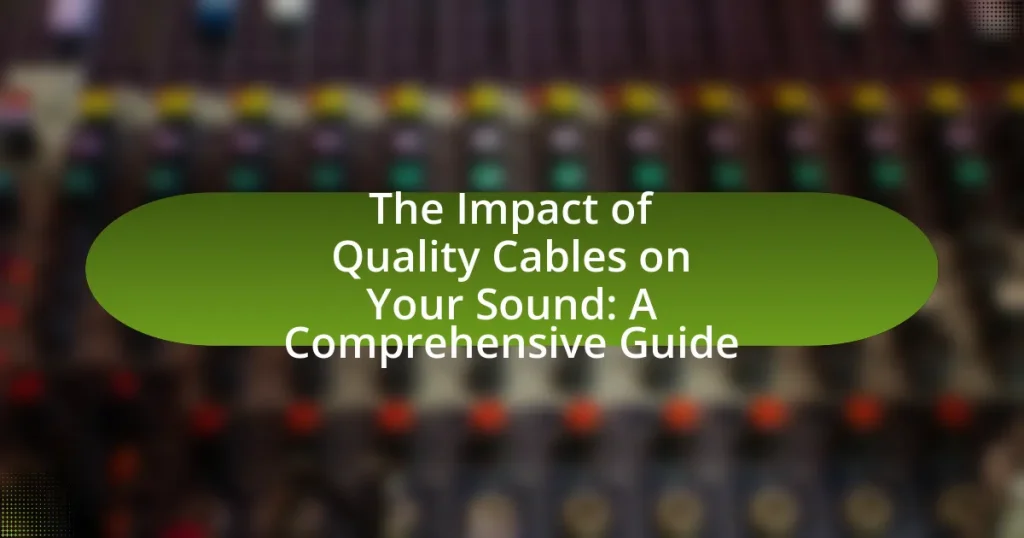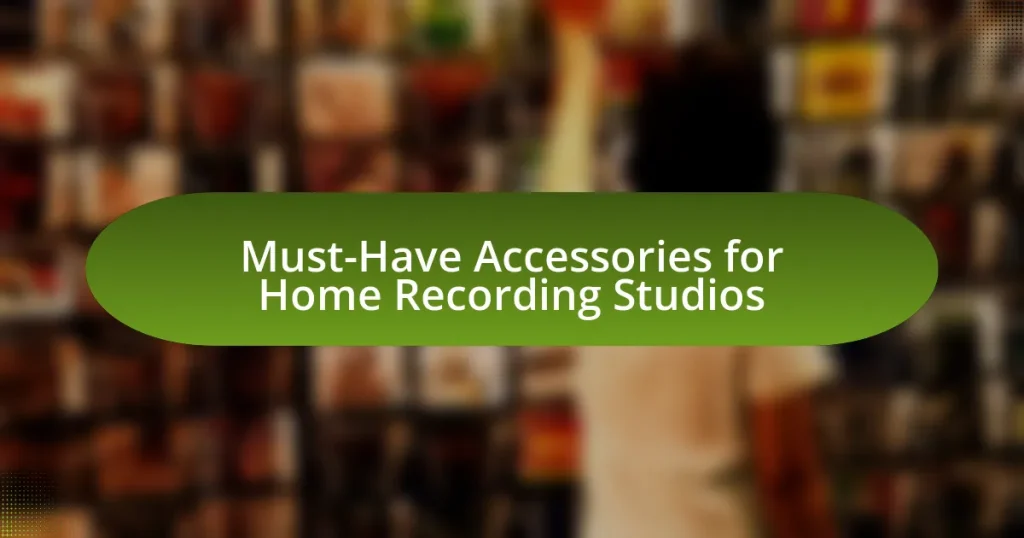The article focuses on essential accessories for enhancing keyboard performance, specifically highlighting the importance of quality stands and pedals. It discusses how ergonomic stands improve comfort and reduce strain, detailing various types such as X-style, Z-style, and adjustable stands. The role of pedals in musical expression is also examined, including different types like sustain, expression, and soft pedals, and their impact on sound dynamics. Additionally, the article emphasizes the benefits of upgrading accessories for improved performance and comfort, providing guidance on selecting the right stands and pedals based on compatibility and personal preferences.

What are the essential accessories for enhancing keyboard performance?
Essential accessories for enhancing keyboard performance include a quality keyboard stand, a sustain pedal, and a keyboard cover. A sturdy keyboard stand provides stability and ergonomic positioning, which is crucial for comfort during long playing sessions. A sustain pedal allows for expressive playing by enabling notes to be held longer, mimicking the functionality of an acoustic piano. Additionally, a keyboard cover protects the instrument from dust and damage, ensuring longevity and consistent performance. These accessories collectively improve the overall playing experience and functionality of the keyboard.
How do stands improve keyboard ergonomics and performance?
Stands improve keyboard ergonomics and performance by allowing users to adjust the height and angle of the keyboard, promoting a more natural wrist position. This adjustment reduces strain on the wrists and forearms, which can lead to discomfort or repetitive strain injuries over time. Research indicates that maintaining a neutral wrist position can enhance typing speed and accuracy, as users can type more comfortably and efficiently. Additionally, stands can help optimize the keyboard’s position relative to the user’s line of sight, further improving posture and reducing neck strain.
What types of keyboard stands are available?
There are several types of keyboard stands available, including X-style stands, Z-style stands, table-style stands, and adjustable stands. X-style stands are popular for their portability and stability, featuring a cross-braced design that allows for easy setup and breakdown. Z-style stands offer a more robust structure with a unique Z shape, providing additional support for heavier keyboards. Table-style stands resemble a flat surface and are ideal for studio settings, allowing for a larger workspace. Adjustable stands can be modified in height and width, accommodating various keyboard sizes and player preferences. Each type serves different needs, ensuring musicians can find a suitable option for their performance or practice requirements.
How do adjustable stands benefit musicians?
Adjustable stands benefit musicians by providing customizable height and angle settings, which enhance comfort and accessibility during performances. This adaptability allows musicians to maintain proper posture, reducing the risk of strain or injury while playing. Research indicates that ergonomic setups can improve performance efficiency and reduce fatigue, making adjustable stands a practical choice for long practice sessions or live shows.
What role do pedals play in keyboard performance?
Pedals play a crucial role in keyboard performance by enhancing expressiveness and control over sound. The sustain pedal, for instance, allows notes to resonate longer, creating a fuller sound and enabling smoother transitions between chords. Additionally, the soft pedal reduces the volume and alters the timbre, allowing for more nuanced playing. The use of pedals can significantly impact the emotional delivery of a piece, as evidenced by their common use in classical and contemporary music to achieve desired dynamics and articulations.
What are the different types of pedals for keyboards?
The different types of pedals for keyboards include sustain pedals, expression pedals, and soft pedals. Sustain pedals, commonly used in digital pianos and keyboards, allow notes to be held longer, mimicking the function of a piano’s damper pedal. Expression pedals control the volume or modulation of sound, providing dynamic control over the performance. Soft pedals, also known as una corda pedals, reduce the volume and alter the timbre of the sound, similar to the soft pedal on an acoustic piano. Each type of pedal enhances the keyboardist’s ability to express musical nuances and improve overall performance.
How do pedals enhance musical expression?
Pedals enhance musical expression by allowing musicians to manipulate sound dynamics and effects in real-time. For instance, sustain pedals enable notes to resonate longer, creating a fuller sound, while expression pedals can control volume and modulation, adding emotional depth to performances. These functionalities are crucial in genres like classical and jazz, where nuanced expression is essential. The use of pedals can significantly alter the auditory experience, as evidenced by their prevalence in professional performances and recordings, demonstrating their importance in achieving artistic intent.

Why should you consider upgrading your keyboard accessories?
Upgrading your keyboard accessories can significantly enhance your performance and comfort while playing. Improved accessories, such as ergonomic stands and high-quality pedals, can reduce strain during long sessions and provide better control over your instrument. For instance, studies show that ergonomic designs can decrease the risk of repetitive strain injuries, which are common among musicians. Additionally, high-performance pedals can offer more responsive action, allowing for greater expression and precision in playing. Therefore, investing in upgraded keyboard accessories is essential for both health and musicality.
What are the advantages of using high-quality stands?
High-quality stands provide enhanced stability and durability for musical instruments, ensuring they remain securely positioned during performances. This stability minimizes the risk of accidents, such as tipping or falling, which can damage both the instrument and the surrounding environment. Additionally, high-quality stands often feature adjustable height and angle settings, allowing musicians to customize their setup for optimal comfort and ergonomics. This adaptability can lead to improved performance quality, as musicians can maintain better posture and access their instruments more easily. Furthermore, high-quality materials used in these stands contribute to their longevity, making them a worthwhile investment for serious performers.
How do premium stands affect stability and comfort?
Premium stands enhance stability and comfort by providing a robust and adjustable platform for keyboards. These stands are typically constructed from high-quality materials that minimize wobbling and vibrations, ensuring that the keyboard remains securely in place during use. Additionally, premium stands often feature ergonomic designs that allow for height and angle adjustments, promoting a more comfortable typing posture. Research indicates that ergonomic setups can reduce strain and fatigue, leading to improved performance and longer practice sessions.
What features should you look for in a keyboard stand?
When selecting a keyboard stand, prioritize stability, adjustability, and portability. Stability ensures that the stand can support the weight of the keyboard without wobbling, which is crucial during performances. Adjustable height allows for customization to suit different playing styles and ergonomic needs, accommodating various user preferences. Portability is essential for musicians who travel, as lightweight and foldable designs facilitate easy transport. Additionally, consider the material quality; metal stands typically offer greater durability compared to plastic options. These features collectively enhance the performance experience and ensure the keyboard remains secure and accessible.
How can the right pedals transform your playing experience?
The right pedals can significantly enhance your playing experience by providing greater control over dynamics and expression. For instance, a sustain pedal allows for smoother transitions between notes, enabling a more fluid performance, while expression pedals can modulate volume and effects in real-time, adding depth to the sound. Studies show that musicians who utilize appropriate pedals report increased satisfaction and creativity during performances, as these tools facilitate a more nuanced interaction with their instrument.
What are the key features of effective keyboard pedals?
Effective keyboard pedals typically feature durability, responsiveness, and compatibility. Durability ensures that the pedals can withstand frequent use without malfunctioning, which is crucial for performers who rely on them during live shows. Responsiveness refers to the pedal’s ability to register input quickly and accurately, allowing for seamless transitions in sound. Compatibility with various keyboard models is essential, as it ensures that the pedals can be used across different setups without issues. These features collectively enhance the performance experience, making them vital for musicians.
How do different pedals cater to various musical styles?
Different pedals cater to various musical styles by providing specific effects that enhance the sound and performance of instruments. For example, distortion pedals are commonly used in rock music to create a gritty, aggressive tone, while reverb pedals are favored in ambient and classical music for their ability to add depth and space to sound. Additionally, modulation pedals, such as chorus and flanger, are often utilized in pop and electronic genres to create lush, dynamic textures. The choice of pedal directly influences the overall character of the music, allowing musicians to tailor their sound to fit the stylistic nuances of their genre.

What should you keep in mind when selecting keyboard stands and pedals?
When selecting keyboard stands and pedals, prioritize stability, adjustability, and compatibility with your keyboard model. Stability ensures that the stand can support the weight of the keyboard without wobbling, which is crucial for performance. Adjustable stands allow for customization of height and angle, accommodating different playing styles and preferences. Compatibility is essential to ensure that the pedals work seamlessly with your keyboard, as not all pedals are universally compatible. For instance, many keyboards require specific types of pedals, such as sustain or expression pedals, to function correctly.
How do you choose the right stand for your keyboard type?
To choose the right stand for your keyboard type, first identify the keyboard’s size and weight, as these factors determine the stand’s compatibility and stability. For instance, a full-sized keyboard typically requires a sturdy, adjustable stand that can support its weight and dimensions, while a compact keyboard may work well with a lighter, portable stand. Additionally, consider the stand’s height adjustment features to ensure ergonomic playing positions, as well as its material for durability; metal stands generally offer more stability than plastic ones. Selecting a stand that matches these specifications ensures optimal performance and comfort during use.
What factors influence the compatibility of stands with keyboards?
The compatibility of stands with keyboards is influenced by several key factors, including the keyboard’s size, weight, and design. Stands must accommodate the dimensions of the keyboard to ensure stability and proper support; for instance, a full-sized keyboard typically requires a wider stand than a compact model. Additionally, the weight of the keyboard affects the stand’s load capacity; stands designed for heavier keyboards must be robust enough to prevent tipping or collapsing. The design of the keyboard, such as whether it has a flat or angled profile, also plays a role, as some stands are specifically engineered to match these ergonomic features for optimal performance.
How can you ensure the stand meets your performance needs?
To ensure the stand meets your performance needs, select a stand that is adjustable and sturdy, allowing for optimal height and angle for playing. A stand with a weight capacity that exceeds the combined weight of your keyboard and any additional accessories will provide stability during use. Additionally, consider stands with features such as locking mechanisms and rubber feet to prevent slipping, which enhances safety and performance. Research indicates that adjustable stands can improve ergonomics, reducing strain during long performances, thus supporting better overall performance quality.
What tips can help you select the best pedals for your music?
To select the best pedals for your music, consider your musical style, the types of effects you want, and compatibility with your keyboard. Different genres may require specific effects; for instance, rock often benefits from distortion and overdrive, while jazz may favor reverb and delay. Assess the range of effects available in pedals, such as modulation, dynamics, and time-based effects, to match your creative needs. Additionally, ensure that the pedals are compatible with your keyboard’s output and input specifications, as this will affect sound quality and performance. Testing pedals in-store or reading reviews can provide insights into their reliability and sound quality, helping you make an informed decision.
How do you assess the quality and durability of pedals?
To assess the quality and durability of pedals, examine the materials used in their construction, the design features, and user reviews. High-quality pedals typically utilize robust materials such as metal or high-grade plastic, which enhance their longevity and resistance to wear. Additionally, features like reinforced connections and weatherproofing can indicate durability. User reviews provide insights into real-world performance and longevity, often highlighting issues or praises that reflect the pedal’s quality over time. For instance, pedals with a history of positive feedback regarding their lifespan and reliability are generally considered superior.
What are common mistakes to avoid when buying keyboard accessories?
Common mistakes to avoid when buying keyboard accessories include not considering compatibility, overlooking quality, and neglecting personal preferences. Compatibility is crucial; for instance, purchasing a stand that does not fit the keyboard size can lead to instability. Quality matters because low-quality accessories can affect performance and durability; research shows that well-made stands and pedals enhance user experience and longevity. Additionally, personal preferences, such as key feel and pedal sensitivity, should guide choices; ignoring these can result in dissatisfaction and hinder performance.
What are the best practices for using keyboard stands and pedals effectively?
The best practices for using keyboard stands and pedals effectively include ensuring stability, adjusting height for comfort, and positioning pedals for accessibility. A stable stand prevents wobbling during performance, which is crucial for maintaining focus and precision. Adjusting the height of the stand to match the player’s seated or standing position enhances ergonomic comfort, reducing strain during extended play. Positioning pedals within easy reach allows for seamless transitions between playing and using effects, which is essential for dynamic performances. These practices are supported by ergonomic studies that emphasize the importance of proper setup in reducing physical strain and improving performance efficiency.



